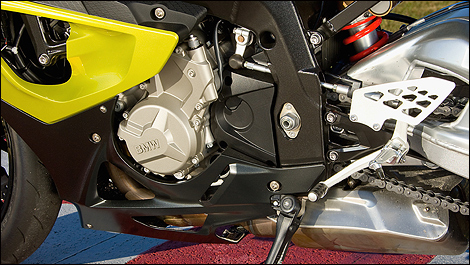The in-line four configuration was chosen to take on the Japanese at their strength, as well as offering a clear advantage in power over two- or three-cylinder engines with heavier reciprocating masses (i.e. pistons, rods, valves), as high revs are the key to high power. Peak power for the S comes around at 13,000 rpm, while the red line is set at 14,250, a nice extension that can reduce the need to change gears near the end of a straight, or while passing a truck on a busy road. Peak torque arrives at 9,750 rpm, with the engine capable of pulling sixth gears from as low as 2,400 rpm, great for urban areas or when the County Mounties are prowling about.
The drive train also features a mechanical slipper clutch, an easy-to-use six speed tranny, and final chain drive. There is not much you can say about a gearbox that shifts so precisely and effortlessly, aided by the Easy Shift electronic assist that cuts power monetarily on upshifts – it works so well that I never noticed it!
 |
| You can see the cover of the swingarm pivot axle, which can be raised or lowered to compensate for changes in ride height and to optimize weight transfer on corner exits. |
Same thing for the slipper clutch, as hard downshifts going into corners never produced the rev spike and rear end tremors we are used to, just a smooth linkup between the engine and gearbox, ready for power when the rider recover his bravery.
Electronics: THE difference
Added-value and added-function electronics is where the RR really stands out, and it does so at two levels. With Dynamic Traction Control (DTC), Race ABS, Easy Shift, variable response throttle-by-wire, linked brakes, and torque smoothing, the 1000 assembles much of the same functions as its direct competitors. For good measure and to open up a new set of possibilities, BMW added lean angle sensors to allow the DTC to better manage torque when the bike is leaned over.
The enormous second level in the RR is how this set of electronic functions works together to create the right behaviour for any given rider and set of riding circumstances. This is where the four “Modes” come into play, as the developers have orchestrated all this code to optimize performance and safety.
Here is how this matrix looks like, with link to another text that describes how things wok and why.
| Mode |
Power / Throttle Response
|
DTC/ABS
Settings |
Power limited @ Lean Angles
|
Wheelie Control |
| Rain |
153 hp, 5%
throttle
dampening |
High DTC
intervention
Anti rear wheel lift ABS |
38º |
5 sec before throttle is reduced |
| Sport |
193hp, 5%
throttle
dampening |
Medium DTC
Anti rear wheel lift ABS |
45º |
5 sec before throttle is reduced |
| Race |
193hp, no
throttle
dampening |
Light DTC |
48º |
None |
|
Slick
|
193hp, no
throttle
dampening |
Very light or no DTC |
53º |
None |

